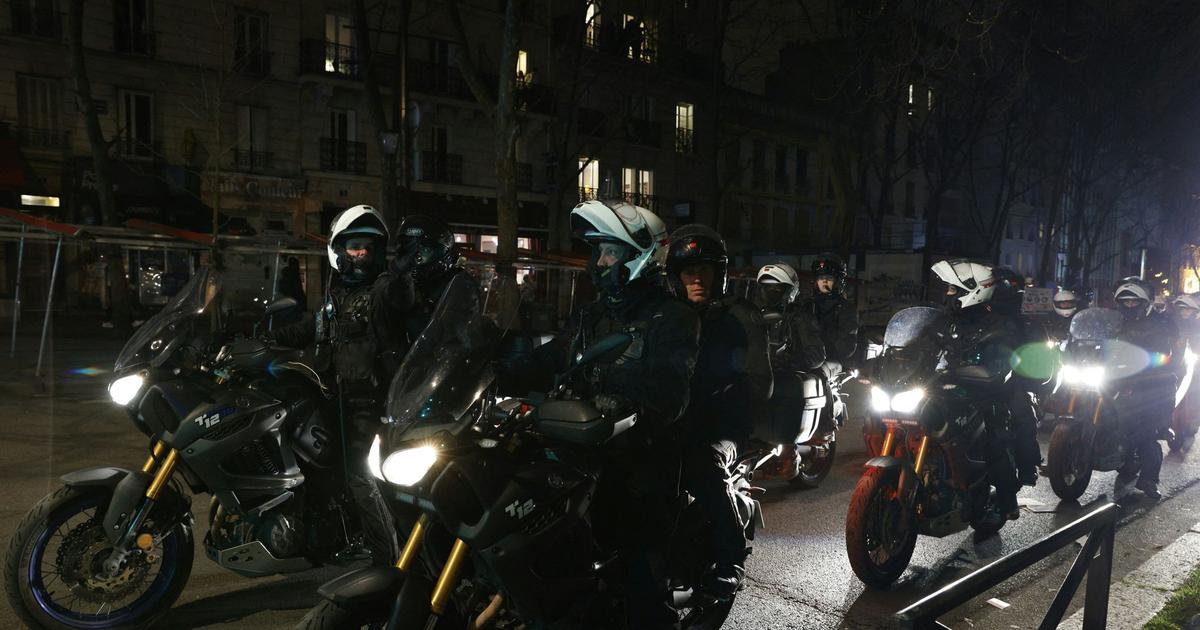The BRAV-M, or Motorized Violent Action Repression Brigades, have been deployed in the streets of Paris in recent days during protests against pension reform.
These motorized police units, created in March 2019 by the former Paris police prefect, Didier Lallement, and mobilized for the first time during the "yellow vests" crisis, were designed to increase the mobility of police forces. order and thus adapt to the new forms of violence observed during the demonstrations.
Read alsoLaw enforcement: Beauvau is looking for a new intervention scheme
Composed of pairs made up of a motorcyclist and a policeman, the BRAV-M are not permanent units, but formed when the authorities fear dispersed violent actions.
Extremely mobile, they make it possible to quickly deploy law enforcement to the scene of confrontation in order to support teams in difficulty, or to intervene in places of degradation and violence.
They are backed up by vans carrying reinforcements and helping to evacuate those arrested.
Shortly after their creation, the Prefecture of Police defined their objective: "
to disperse the groups, according to a graduated and proportionate use of force and to carry out a maximum of arrests
".
And for the past few days, faced with the multiplication of wild demonstrations and the risk of overflows on the sidelines of large rallies organized by the unions, the prefect of police Laurent Nuñez has decided to deploy these mobile brigades once again, mainly in the capital.
They intervene in particular in the context of the spontaneous gatherings which have multiplied since Elisabeth Borne initiated 49.3 in the National Assembly to adopt the pension reform.
These social movements do not take the usual form of a compact and clearly identifiable procession, but are divided into small groups which scatter in the streets and often degrade street furniture.
Trash fires, improvised barricades, broken bus stops, the brigades intervened quickly in several places in the capital.
LFI elected officials ask for their dissolution
But they are far from unanimous.
If they had already sparked heated debate during demonstrations of "yellow vests" in 2019, they are today decried by many demonstrators and elected officials on the left.
And in particular on the side of insubordinate France, which, through the mouth of three parliamentarians, asks for their “
dissolution
”.
Antoine Léaument (Essonne), Thomas Portes (Seine-Saint-Denis) and Ugo Bernalicis (Nord) denounce, in a letter addressed to the Minister of the Interior Gérald Darmanin, "drifts" in the techniques of maintaining
order
.
LFI elected officials go even further and affirm that these brigades, “
far from ensuring a return to appeasement
”, contribute to “
the increase in tensions
“, reports franceinfo.
MP Thomas Portes sees it as "one of the symbols of police violence", originally created to "
gag the movement of 'yellow vests'
".
Brigades created during the "yellow vests"
But what was really the objective of these brigades when they were created?
Make law enforcement more mobile and autonomous.
And for the specialists, this ambition was not new.
For Aurélien Restelli, doctoral student at Versailles Saint-Quentin University, "
since the 1990s we have been thinking about it, but the 'yellow vests' demonstrations have increased the need for reactivity from the police
".
The modus operandi of the "thugs", who divide the police and gendarmerie forces by operating in various places, weakens their effectiveness.
For Loïc Travers, Île-de-France national secretary of the Alliance police union, “
the looters understood that to put the police in trouble, they had to disperse.
Traditional static methods don't work because we fail to account for scatter.
»
In December 2018, the former prefect of Paris Michel Delpuech had created the DAR (Rapid Action Detachments), mainly composed of police officers from the BAC - and therefore not specialists in maintaining order - to carry out arrests and police on motorcycles had been observed in the streets of Paris.
The advantages of two-wheelers are numerous: they don't have to park, they can more easily take the wrong way, side alleys, or can roll on the sidewalks to get to the points of tension.
The BRAV-M, unlike the DAR, mobilize more forces specialized in the maintenance of order, that is to say in the management of demonstrations.
Each of the members of the pairs is trained for this type of invention.
In Paris, of the 60 police officers authorized to intervene in BRAV-M, 40 come from the Intervention Companies (CI), units trained in maintaining order, and 20 from the BAC (Anti-Crime Brigade), specialized in the interpellation.
On May 1, 2019, for the first time, gendarmes had been mobilized, according to L'Essor, a newspaper specializing in gendarmerie news: it was the Motorcycle Squadron of the Presidential Guard - the motorized unit of the Republican Guard.
“The motorcycles we use are only used to transport our agents”
The deployment of the BRAV-M is reminiscent of the Voltigeurs, these police officers mounted in pairs on a motorcycle, one piloting, the other armed with a "
bidule
", a large wooden baton, to disperse the demonstrators. and hunt down the thugs.
These units were disbanded in 1986 following the death of Malik Oussekine, a student beaten by three acrobats on the sidelines of student protests in Paris.
The operating mode of the BRAV-M and the DAR is on the other hand different as Didier Lallement specified, last April: “
While the aerialists acted from motorized vehicles, the motorcycles that we use are only used to transport our agents.
»

